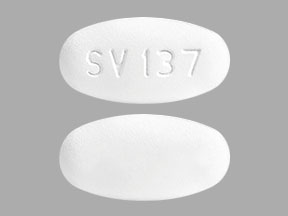Dolutegravir/lamivudine and Alcohol/Food Interactions
There are 3 alcohol/food/lifestyle interactions with dolutegravir / lamivudine.
Multivitamins With Minerals Dolutegravir
Major Drug Interaction
ADJUST DOSING INTERVAL: Coadministration with medications containing polyvalent cations such as aluminum, calcium, iron, or magnesium may decrease the oral bioavailability of dolutegravir. The mechanism of interaction likely involves chelation of dolutegravir by the polyvalent cation in the gastrointestinal tract. In 16 study subjects, administration of a single 50 mg dose of dolutegravir simultaneously with an antacid containing magnesium and aluminum decreased dolutegravir peak plasma concentration (Cmax), systemic exposure (AUC) and trough plasma concentration (Cmin; 24 hours post-dose) by 72%, 74% and 74%, respectively, compared to administration without the antacid. When the antacid was administered 2 hours after dolutegravir, the Cmax, AUC and Cmin of dolutegravir decreased by just 18%, 26% and 30%, respectively. Administration of single-dose dolutegravir simultaneously with a multivitamin decreased the Cmax, AUC and Cmin of dolutegravir by 35%, 33% and 32%, respectively. Coadministration of dolutegravir with calcium carbonate or ferrous fumarate under fed conditions counteracted the interaction and provided plasma exposures comparable to dolutegravir alone under fasted conditions.
MANAGEMENT: Dolutegravir should be administered 2 hours before or 6 hours after medications containing polyvalent cations such as antacids, laxatives, or mineral supplements. When taken with food, dolutegravir and supplements or multivitamins containing calcium or iron can be taken at the same time.
References (4)
- (2013) "Product Information. Tivicay (dolutegravir)." ViiV Healthcare
- (2019) "Product Information. Dovato (dolutegravir-lamivudine)." ViiV Healthcare
- (2024) "Product Information. Dovato (dolutegravir-lamivudine)." ViiV Healthcare UK Ltd
- (2024) "Product Information. Dovato 50/300 (dolutegravir-lamiVUDine)." ViiV Healthcare
Dolutegravir Food/Lifestyle
Minor Food Interaction
Food increases the extent of absorption and slows the rate of absorption of dolutegravir. When administered with a low-, moderate- or high-fat meal, dolutegravir peak plasma concentration (Cmax) increased by 46%, 52% and 67%, systemic exposure (AUC) increased by 33%, 41% and 66%, and time to reach Cmax (Tmax) increased from 2 hours to 3, 4 and 5 hours, respectively, compared to administration under fasted conditions. Dolutegravir may be taken with or without food.
References (1)
- (2013) "Product Information. Tivicay (dolutegravir)." ViiV Healthcare
Switch to consumer interaction data
Lamivudine High Cholesterol (Hyperlipoproteinemia, Hypertriglyceridemia, Sitosterolemia)
Major Potential Hazard, Moderate plausibility
NRTIs - pancreatitis
The nucleoside reverse transcriptase inhibitors, didanosine, stavudine, and lamivudine, may cause pancreatitis. The incidence is generally low but is up to 7% with didanosine, and up to 18% in pediatric patients given lamivudine. Patients with a history of or known risk factors for pancreatitis (such as alcohol abuse or hypertriglyceridemia) should be monitored closely during therapy with these agents. Therapy should be discontinued at the first signs/symptoms suggestive of pancreatitis (e.g., nausea, vomiting, abdominal pain, hyperamylasemia with dysglycemia, rising triglycerides, decreasing serum calcium), and preferably permanently discontinued if clinical pancreatitis develops.
References (3)
- (2019) "Product Information. Epivir (lamiVUDine)." ViiV Healthcare, SUPPL-39
- (2018) "Product Information. Videx (didanosine)." Bristol-Myers Squibb, SUPPL-54
- (2018) "Product Information. Zerit (stavudine)." Bristol-Myers Squibb, SUPPL-41
Switch to consumer interaction data
Dolutegravir/lamivudine drug interactions
There are 207 drug interactions with dolutegravir / lamivudine.
Dolutegravir/lamivudine disease interactions
There are 7 disease interactions with dolutegravir / lamivudine which include:
More about dolutegravir / lamivudine
- dolutegravir/lamivudine consumer information
- Check interactions
- Compare alternatives
- Reviews (50)
- Side effects
- Dosage information
- During pregnancy
- Drug class: antiviral combinations
- En español
Related treatment guides
Drug Interaction Classification
| Highly clinically significant. Avoid combinations; the risk of the interaction outweighs the benefit. | |
| Moderately clinically significant. Usually avoid combinations; use it only under special circumstances. | |
| Minimally clinically significant. Minimize risk; assess risk and consider an alternative drug, take steps to circumvent the interaction risk and/or institute a monitoring plan. | |
| No interaction information available. |
See also:
Further information
Always consult your healthcare provider to ensure the information displayed on this page applies to your personal circumstances.


